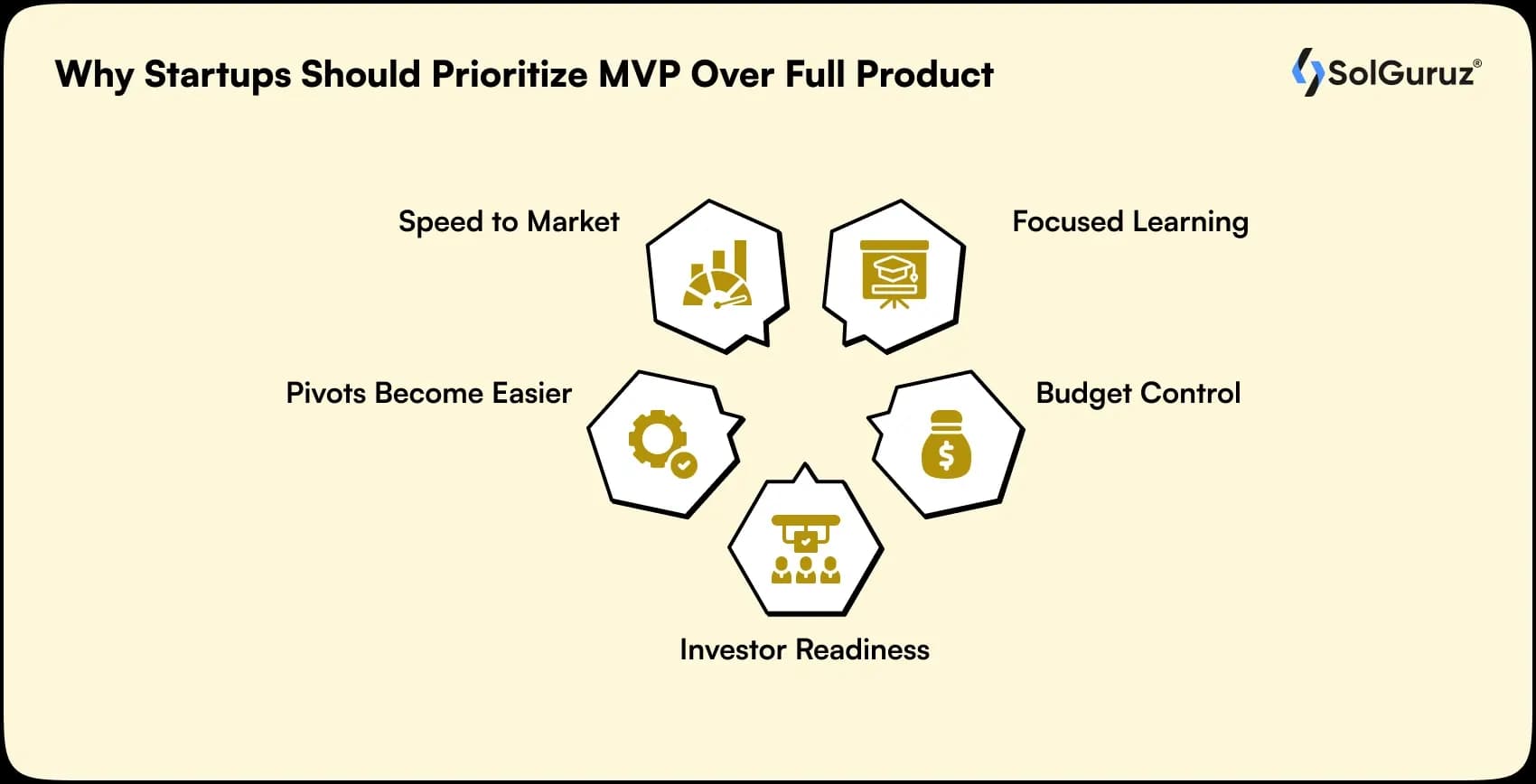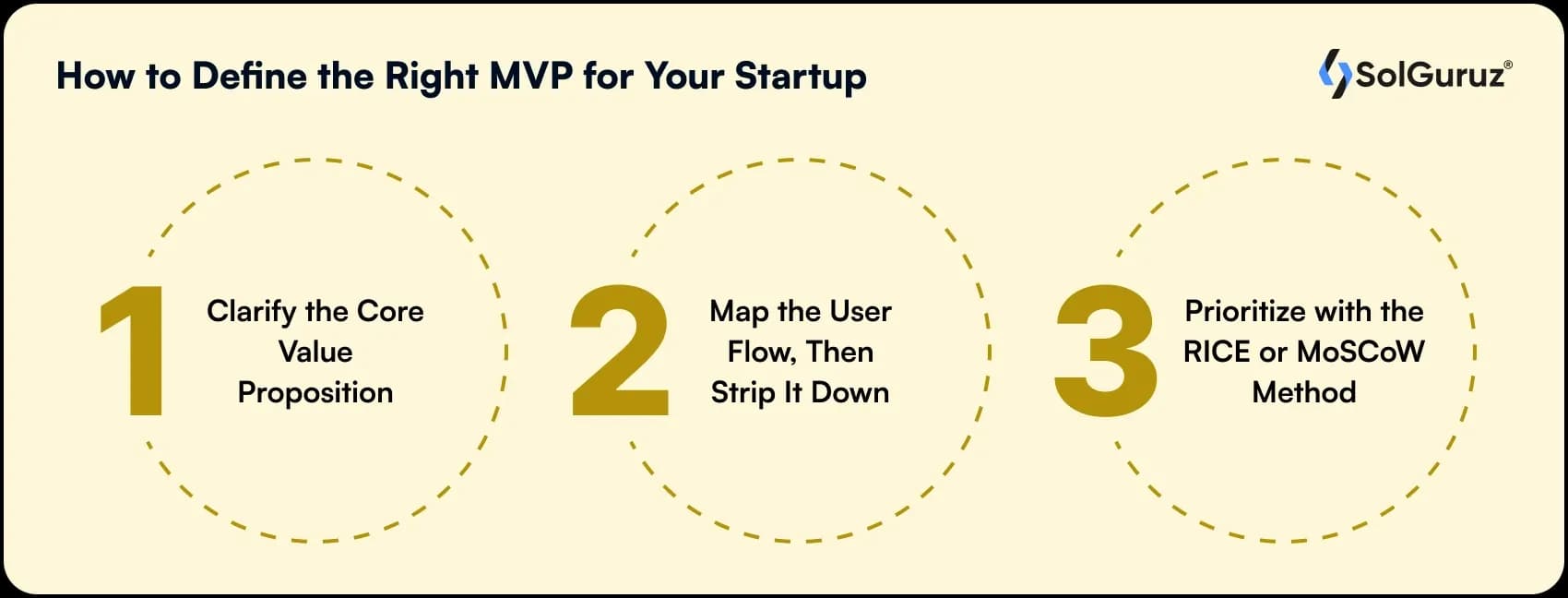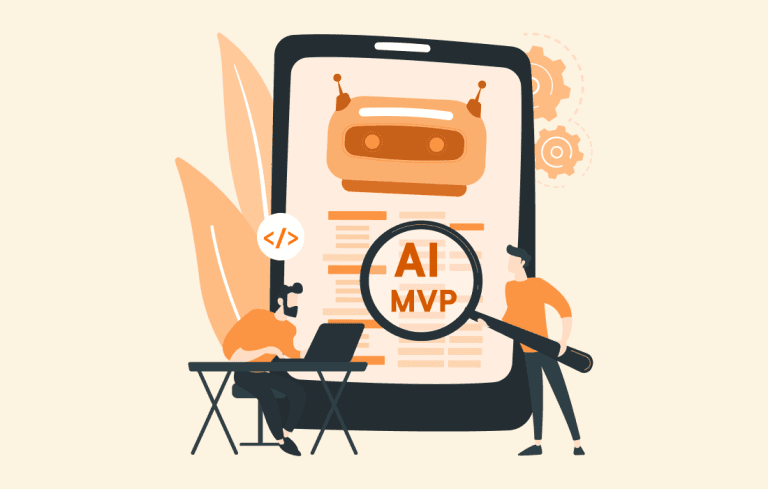MVP Development for Startups: A Founder’s Guide to Building Smart, Fast, and Lean
This guide breaks down MVP development for startups what it is, why it matters, and how to execute it efficiently. Learn to define the right MVP, choose the best development method, estimate costs, and avoid common mistakes while validating your idea fast and within budget.

Most early-stage startups don’t fail because of bad code or weak design. They fail because they spend 6–12 months building something no one actually wants.
The real challenge isn’t building fast—it’s building with certainty.
That’s where MVP development comes in.
A well-defined MVP helps you:
- Validate your riskiest assumption early,
- Reduce unnecessary spending,
- Start learning from real users (before your burn rate becomes a problem)
It works even if you’re a solo founder without a tech co-founder or a team.
This guide will show you how to scope, build, and launch a smart MVP that moves your startup forward.
We’ll cover the strategic thinking, processes, costs, and execution paths that actually work + insights from building MVPs across industries at SolGuruz.
Table of Contents
What Is MVP Development (And What It’s Not)
Let’s get this out of the way: MVP is not a prototype. It’s also not a buggy version of your dream product.
An MVP is the simplest functional version of your product that solves a core problem for a specific audience—and does it well enough that you can learn from real user behavior.
You can consider an MVP as a conversation starter between your idea and your market.
Common MVP Myths:
- Myth: MVP means releasing something broken or half-ready.
- Reality: A good MVP should be polished enough to be usable and testable.
- Myth: MVP is only for tech startups.
- Reality: Any startup can (and should) validate before scaling.
- Myth: It has to be built with code.
- Reality: MVPs can be built using no-code tools, landing pages, or even concierge services.
At SolGuruz, we help startups map out MVPs that are realistic, efficient, and built to validate fast. Learn how we approach MVPs.
Why Startups Should Prioritize MVP Over Full Product

In early-stage startups, time and money are your most finite resources. MVP development gives you a way to test your riskiest assumptions before burning through either.
Here’s why you should build MVP first:
1. Speed to Market
You don’t need to wait 6-12 months to see if your idea has legs. An MVP can get you market feedback in weeks.
2. Focused Learning
Instead of building for imagined use cases, you learn from actual user behavior.
3. Budget Control
By prioritizing only what matters, you stretch your runway and reduce waste.
4. Investor Readiness
Many pre-seed/seed investors want to see some traction—a well-executed MVP shows you can ship, learn, and iterate.
5. Pivots Become Easier
Smaller scope = faster course correction.
FYI: Dropbox was earlier launched as a simple “demo video” which was used to validate user interest before writing a single line of code.
How to Define the Right MVP for Your Startup

A solid MVP doesn’t start with features. It starts with clarity—on your users, their core problem, and the single job your product must do well.
Here’s how to break it down:
1. Clarify the Core Value Proposition
What is the most critical problem your product solves, and for whom?
If you can’t express the answer in one sentence, the scope isn’t clear enough to build. The MVP should solve one high-friction problem for a clearly defined user segment.
Example: Before Uber had route optimization or ratings, it solved just one painful problem—getting a cab quickly via an app.
2. Map the User Flow, Then Strip It Down
Sketch the full user journey: from landing on your site to solving their problem. Then remove everything that’s not essential to that first value delivery.
This is how you shift from feature-thinking to value-thinking.
3. Prioritize with the RICE or MoSCoW Method
These are two effective ways to avoid scope creep:
- RICE: Reach, Impact, Confidence, Effort
Focus on features that impact the most users, with high confidence and low effort. - MoSCoW: Must-Have, Should-Have, Could-Have, Won’t-Have
Categorize features ruthlessly. MVP = only the must-haves.
MVP Development Process (Step-by-Step)

Once you’ve defined the right MVP, execution becomes a game of focus and iteration.
Here’s the step-by-step framework we usually follow:
Step 1: Problem Validation
Before building anything, validate that the problem is real and painful enough. This can be done through surveys, customer interviews, or traction on a waitlist.
Step 2: Solution Hypothesis and Flow Design
Sketch the solution in terms of how it works, not how it looks. Create user flows that match real-world usage. Use Figma or tools like Whimsical to iterate quickly.
Step 3: Feature Prioritization
Apply RICE or MoSCoW here to scope the minimum set of features required for the product to be usable and testable.
Step 4: Prototype or UX Design
Design clickable mockups or a visual prototype to gather feedback before development. Tools like Figma or Webflow can be used at this stage.
Step 5: MVP Development Sprint
Now you build. You need to choose the fastest development route without compromising on data accuracy, responsiveness, or user trust.
This could be no-code (for internal tools or tests), hybrid (Bubble + custom backend), or full-stack development.
Step 6: Launch and Collect Feedback
Deploy to a closed group. Measure retention, task completion, and friction points. Replace opinions with data. The objective here is learning velocity—not polish.
MVP Development Methods: In-House vs Freelancers vs MVP Agencies
Choosing the right execution path for your MVP isn’t just about budget.
Here’s a comparison based on what we’ve seen across early-stage startup teams:
|
Method |
Advantages |
Limitations |
Best For |
| In-House Team | Full control, long-term continuity | High hiring cost, long ramp-up, needs a strong tech lead | VC-backed teams with in-house talent |
| Freelancers | Low cost, flexible, quick to hire | Varying quality, lack of product thinking, and no process | Simple MVPs, exploratory builds |
| Agencies | Speed, process maturity, and startup-aligned workflows | Higher upfront cost, need to trust in the partner | Time-constrained non-technical founders |
If you’re a solo or non-technical founder, coordinating 2–3 freelancers can feel like managing a small team that has no clarity of outcomes.
Cost of MVP Development (with Ranges)
There’s no universal price tag for MVP development, but based on over a hundred early-stage builds, here’s a reliable breakdown based on approach and complexity.
| Build Type | Typical Range | Timeline | Notes |
| No-code MVP | $5K – $15K | 2–4 weeks | Fastest, best for internal tools or validation tests |
| Hybrid (No-code + Dev) | $10K – $25K | 3–6 weeks | Combine visual builders with custom backend logic |
| Full-Custom Build | $25K – $60K+ | 6–10 weeks | Needed when UX, scale, or security is a core factor |
A lean MVP should be optimized for learning and growth. So, before you spend $50K on features that haven’t been validated, you can start with a $15K test version and iterate based on what they discover.
Need Help With MVP Development?
If you’re in the early stages of building your startup, the smartest investment you can make isn’t in more features – it’s in clarity.
At SolGuruz, we work with founders to turn raw ideas into usable, testable MVPs.
We help them from idea validation and scoping to UX design and full-cycle development.
Our USP? We bring the structure and speed early-stage teams need.
Whether you have a concept on paper or are pivoting from an earlier build, we help you move fast—without building blind.
Services we offer:
- MVP Strategy & Scoping Workshops
- UX/UI Design & Prototyping
- No-code/Low-code MVP Builds
- Custom Full-Stack MVP Development
FAQs
1. How long does MVP development usually take?
Most MVPs we build at SolGuruz are completed in 4–8 weeks, depending on the scope and tech stack. Fast feedback is the priority.
2. Do I need a technical co-founder to start?
Not necessarily. If you work with an experienced MVP development agency, you can easily validate your product idea without having in-house technical talent.
3. How much should I budget for an MVP?
Usually, building an MVP costs around $10K to $50K. For a lite MVP, the cost can be under $20K for sure.
4. What tech stack is best for MVP development?
The tech stack is chosen based on speed, scalability needs, and your post-MVP roadmap. Examples include Firebase + React for speed, or no-code solutions for internal tools.
5. Should I prototype before building the MVP?
Yes, prototyping reduces rework, clarifies scope, and allows for early user testing—especially important if you’re fundraising or pitching pre-launch.
Plan Your MVP with an Expert
Not sure how to scope or build your MVP? Book a free 30-minute strategy call with our product team.

Strict NDA

Trusted by Startups & Enterprises Worldwide

Flexible Engagement Models

1 Week Risk-Free Trial
Give us a call now!

+1 (724) 577-7737


